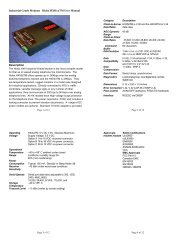You also want an ePaper? Increase the reach of your titles
YUMPU automatically turns print PDFs into web optimized ePapers that Google loves.
<strong>AT</strong> <strong>Commands</strong> <strong>Reference</strong> <strong>Manual</strong><br />
The semicolon is not necessary when the extended syntax command is the last command<br />
on the command line.<br />
Concatenating <strong>Commands</strong> after Basic Format <strong>Commands</strong><br />
Extended syntax commands may appear on the same command line after a basic syntax<br />
command without a separator, in the same manner as concatenation of basic syntax<br />
commands.<br />
2.5 Issuing <strong>Commands</strong><br />
All characters in a command line must be issued at the same data rate, and with the<br />
same parity and format.<br />
The modem will ignore any command line that is not properly terminated. The modem<br />
may consider 30 seconds of mark idle time between any two characters as an improperly<br />
terminated command line. In this case the modem may or may not generate an ERROR<br />
message. The modem will ignore any characters received from the DTE that are not part<br />
of a properly-formatted command line.<br />
If the maximum number of characters that the modem can accept in the body is exceeded,<br />
an ERROR result code is generated after the command line is terminated.<br />
The DTE will not begin issuing a subsequent command line until at least one-tenth of a<br />
second has elapsed after receipt of the entire result code issued by the modem in response<br />
to the preceding command line.<br />
2.6 Executing <strong>Commands</strong><br />
Upon receipt of the termination character, the modem commences execution of the<br />
commands in the command line in the order received from the DTE. Should execution of<br />
a command result in an error, or a character be not recognized as a valid command,<br />
execution is terminated, the remainder of the command line is ignored, and the ERROR<br />
result code is issued. Otherwise, if all commands execute correctly, only the result code<br />
associated with the last command is issued; result codes for preceding commands are<br />
suppressed. If no commands appear in the command line, the OK result code is issued.<br />
2.6.1 Aborting <strong>Commands</strong><br />
Some action commands that require time to execute may be aborted while in progress;<br />
these are explicitly noted in the description of the command. Aborting of commands is<br />
accomplished by the transmission from the DTE to the modem of any character. A single<br />
character is sufficient to abort the command in progress; however, characters transmitted<br />
during the first 125 milliseconds after transmission of the termination character are<br />
ignored (to allow for the DTE to append additional control characters such as line feed<br />
after the command line termination character). To ensure that the aborting character is<br />
recognized by the modem, it should be sent at the same rate as the preceding<br />
command line; the modem may ignore characters sent at other rates. When such an<br />
aborting event is recognized by the modem, the modem terminates the command in<br />
progress and returns an appropriate result code to the DTE, as specified for the particular<br />
command.<br />
2-8<br />
Conexant<br />
100722B








